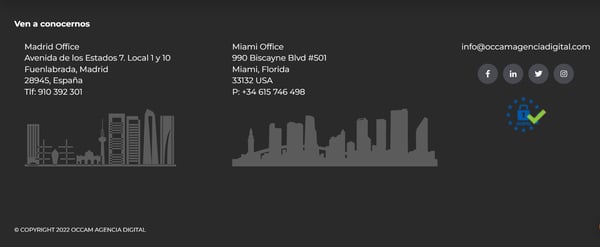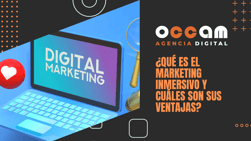Index Content
Web design must be millimetric in order to reach all parts of a page, including the footer
The footer, also known as the footer, is the end of the web structure and the last thing that appears to the user when browsing the page. It is very useful for offering elements of interest to Internet users that may go unnoticed during the rest of the web. Its presence is obligatory to guarantee the usability of any page, whatever its nature. This is because users, when searching for information on a company's website or on a friend's blog, have become accustomed to the footer guaranteeing minimum resources that offer solutions.
Main characteristics of the footer
Each part of a web page has specific features that make navigation easier for the user. In the case of the footer, these are its basic qualities:
- it has its own appearance. With regard to design, it is necessary to differentiate the footer from the rest of the structure so that Internet users identify it as the end of the website. This is where the use of colours comes into play (especially for the background), typographies, font size, division elements (such as a horizontal stripe), etc. Even so, it is essential that all these resources coincide with the corporate image and the general appearance of the website.
- it is defined by its specific location. As we have already seen, the footer has a reserved space within the page: the end. The same applies to the rest of the web structure: the header is at the beginning, the content in the middle and the sidebar on the right or left side. As exceptions, in "infinitescroll " pages the footer may appear in a floating tab, while some mobile versions may require a user action in the form of a dropdown.
- it is a source of information. Users, out of habit and convenience, look for the footer to find data that is usually located in this part of the website (we will see which ones later).
- it is permanent: whatever page of the website the user is on, the footer is present on all of them.
As a practical example, you can take a look at the footer of our website:

Elements you can include in the footer
If you have reached this article, surely you are used to surfing web pages and you have an idea of what information appears in the footer. Even so, it is convenient to compile all the elements that can be included in this section of the web structure to take them into account. It is worth mentioning that it is not necessary to add them all (in fact, it may be counterproductive), but only those that add richness to the user's experience with your website in particular. Let's see them one by one:
- "About...", "About us" or "Who we are". These are general information about the company or the profile of the blog's creator so that users get an idea of its values and scope of action.
- contact details: The star element of the footer. Often, Internet users come to a page looking for contact methods and, if they cannot find it in the main menu, they will probably go to the end of the website. Therefore, it is advisable to include all possible forms of communication: email, telephone, form, etc.
- physical location: Related to the previous point, it is common to include the address of the company (if desired, accompanied by a map) as another possible form of contact. In addition, this can improve your local SEO positioning thanks to geolocation.
- legal information: As a source of transparency, it is convenient for users to have access to the legal notice, copyright, privacy policy, general terms and conditions, cancellation policy, etc.
- security guarantees. Something as simple as a symbol that guarantees data protection increases the credibility of your website, as well as the opinions of other users or prestigious certifications (such as awards).
- site map: It may be convenient to include all the pages that make up the website, but if the structure is too broad it can be counterproductive. Even so, it is recommended to include the main pages.
- newsletter subscription, if available.
- social media icons to foster the creation of a community of your most loyal followers.
- logo or other corporate elements to help visual brand recognition.
- payment methods, in the case of e-commerce.
- other pages of interest to the user, such as frequently asked questions, the latest blog posts, information on employability, etc.

Tips for designing the footer
Finally, and as a review, OCCAM presents seven suggestions that you can follow when configuring the footer of your website, always think about the user:
- always think of the user. This is a global recommendation that affects all the other tips. The aim of the footer is to make browsing easier for Internet users, so all decisions should be taken in this direction.
- do not saturate with an excess of information and, at the other extreme, do not leave the footer empty. Neither black nor white; you have to find a balance. Each page has different needs, so identify the needs of your website and try to meet them.
- choose the elements with criteria. Try to put yourself in your visitors' shoes and think about what they would like to find in this part of the website. If something doesn't fit, then don't include it.
- keep links up to date, whether they are internal or external. It is not recommended to include pages with outdated information or inactive social media icons.
- although the footer can help with the positioning of your website, do not focus its design on optimising SEO. It is a fact that links in this part of the website do not serve to improve the positioning of a page in search engines. Therefore, forget about including links just for SEO; instead, create hyperlinks with relevant information for users. Do not use your keywords excessively: although you can take them into account, add them organically. Otherwise, the algorithm may penalise you for bad practice.
- do not use tags. In relation to the previous point, H tags for titles in the footer have no impact on SEO, so it is best not to include them and avoid possible confusion by the algorithm.
- think about responsive design. It is common for the footer to include several columns, so it is essential to think about adapting this part of the website for different devices. It must be perfectly manageable both from the computer and from a mobile phone or tablet.





